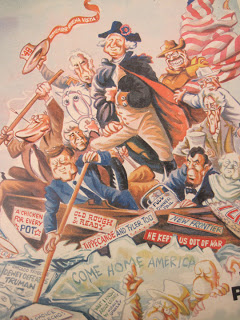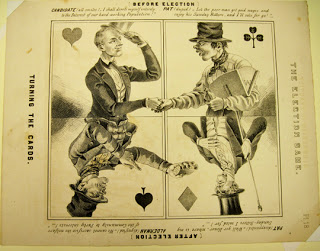Guest post by Molly Malcolm, Clements Library volunteer
Many of the holdings in the graphics division here at Clements are a form of political satire, which seems especially relevant and interesting during this election year. Presidential races have a strong history as opportunities for media outlets to employ satire to create divisions in public opinions. These divisions occur over differing viewpoints and belief systems and are often created in an effort to ensure a specific party’s political victory. Satirical cartoons can both exemplify and exacerbate already existing political tensions, as print media is used to judge electoral histories and political ideologies in an ironic way. Throughout history we have understood political information about candidates using visual aids that help define and solidify our feelings toward their policies and personal lives. The derisiveness of political parties and the negativity focused on presidential candidates is, unfortunately, a longstanding tradition of American political media.
In 1980 the Detroit Free Press printed a cartoon that exemplified this long, ironic past in a humorous and unapologetic way. This print speaks to the heart of our political frustrations with the turbulence and insincerity of the Presidential electoral process.
 |
| “The People’s Choice,” The Detroit Free Press (January 13, 1980) |
Historically, the media has used satirical cartoons to both establish and judge our societal values. One of the Clements’ most frequently requested items is a cartoon of President Andrew Jackson from 1835. The cartoon depicts his position on Native American governmental policies and sarcastically portrays him as a kind ‘father-figure’ to disenfranchised Native Americans. This cartoon, commenting on President Jackson’s passage of the Native American Removal Act five years earlier, attempted to infuse humor into our sometimes brutal political processes. The fact that newspapers printed cartoons like this one ensured that everyday Americans examined national political issues, which helped to hold governmental leaders accountable for their actions by the very people who elected them. This print here at the Clements Library may be the only printed copy that remains in existence today.
 |
| [Andrew Jackson as the Great Father] (ca. 1835) |
In addition to commenting on presidential policies, political satire can also portray voters’ daily lives, highlighting the disillusionment they may feel toward their elected officials. This is depicted in the following disheartened, untrusting cartoon from 1851. At times, citizens have felt cheated and lied to by their Presidents, as if individual voters were pawns in a grand political scheme where the ends justified the dishonest means.
 |
| “The Election Game: Turning the Cards” (1851). |
Our national history is one of great expectations: incredibly tense election cycles where we expect our newly elected President to ratify every broken aspect of our culture. Satire is often employed as a way to vent our frustrations and voice dissent from our electorates. Throughout these cycles of expectation and frustration, cartoons are used to both educate the public and criticize the legislative choices of our governmental bodies in the hope of effecting political change.
In our current election year, we see numerous images every day designed to solidify political boundaries and ensure our votes on one side of the aisle or the other. Right vs. Left, Red vs. Blue. Such polarization is partly achieved through political commentary in modern media sources, which was the same aim of the satirical cartoons of our past. The historical pattern of ironic printed materials that commented on political agendas is quite powerful when applied to contemporary society. After viewing some of the rich historical material we have here at Clements and examining the impact that it has had on our electoral past, the power of visual aids in the media can be understood differently, especially in the context of the upcoming November election.
Further Examples:
- Handicap Race, Presidential Stakes 1844 by Edward Williams Clay
- Shall I vote for 10 cents a day? Published in 1856
- Democracy against the Unnatural Union : trial Octr. 14, 1817
- Protecting the American home, by Art Young. Published in 1892
- Platforms Illustrated. Published by L. Prang & Co.?, 1864
